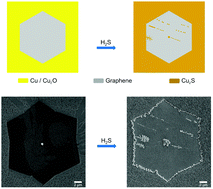In situ chemical probing of hole defects and cracks in graphene at room temperature†
Abstract
Chemical vapor deposition (CVD) has emerged as the most promising technique towards manufacturing of large area, high quality graphene. Characterization, understanding, and controlling of various structural defects in CVD-grown graphene are essential to realize its true potential for real-world applications. We report a new method for in situ chemical probing of vacancy defects in CVD-grown graphene at room temperature. Our approach is based on a solid–gas phase reaction that occurs selectively in graphene vacancy defect regions such as holes and cracks. Our new probing technique has a unique combination of the following advantages: (1) no exposure to liquids; (2) non-damaging in situ probing; (3) high selectivity, sensitivity, and reliability towards vacancy defects; (4) simplicity and scalability. By focusing on hexagonal graphene domains, we have made the following findings: (1) the nucleation centers of graphene domains are favorable locations of hole defects. (2) The lengthy electron-beam irradiation at very low energy (3.5 keV) could etch the graphene. (3) Graphene cracks often kink at the angle of primarily 150° or 120°. (4) There exist complex graphene cracks such as cracks with clock-hands patterns, and cracks with snowflake-like branched structures. (5) There exist discontinuous cracks in some graphene domains, where hole defects are oriented along a straight or curved line. Such discontinuous cracks may arise from the ductile fracture of graphene. In addition, we have shown that our method is also applicable to chemical probing of vacancy defects such as holes, continuous and discontinuous cracks in CVD-grown monolayer polycrystalline graphene films on copper. Our study also suggests that the copper grain and copper grain boundary play significant roles in formation and distribution of graphene vacancy defects.



 Please wait while we load your content...
Please wait while we load your content...